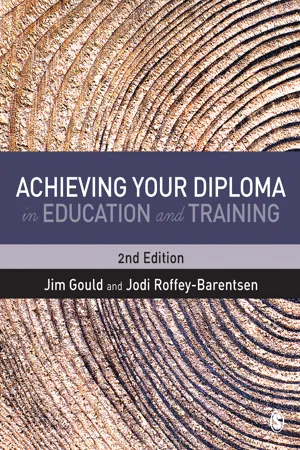
- 416 pages
- English
- ePUB (mobile friendly)
- Available on iOS & Android
Achieving your Diploma in Education and Training
About this book
This book supports the Level 5 Diploma in Education and Training for anyone training to teach in the further education and skills sector. Full of informed practical guidance and supported by meaningful links to theory and educational research, it covers all mandatory units included in the diploma and has been carefully designed to be your indispensable guide to successfully achieving the qualification.
Thought-provoking activities in every chapter highlight key points and show how you can apply them in practice allowing you to enhance your teaching skills. This book clearly communicates what underpins high-quality teaching and empowers you to succeed as a teacher of learners in the further education and skills sector.
New to this edition:
· Reflective activities in every chapter encouraging you to engage critically with key concepts
· New coverage of employability offering pragmatic guidance for succeeding in the workplace
· Content updated to reflect current policy directions within the sector
· Links to further reading throughout highlighting key literature on each major topic
Frequently asked questions
- Essential is ideal for learners and professionals who enjoy exploring a wide range of subjects. Access the Essential Library with 800,000+ trusted titles and best-sellers across business, personal growth, and the humanities. Includes unlimited reading time and Standard Read Aloud voice.
- Complete: Perfect for advanced learners and researchers needing full, unrestricted access. Unlock 1.4M+ books across hundreds of subjects, including academic and specialized titles. The Complete Plan also includes advanced features like Premium Read Aloud and Research Assistant.
Please note we cannot support devices running on iOS 13 and Android 7 or earlier. Learn more about using the app.
Information
1 Education and Training: The Teacher’s Role and Responsibilities
- categorise the different roles fulfilled by the teacher in the Further Education and Skills sector and give examples of these roles
- describe the specific responsibilities associated with the teaching role
- define the following terms: diversity, inclusion, differentiation, equality
- state the different aspects of diversity exhibited by learners within Education and Training
- recognise that different learners have different preferences in learning style
- list different strategies employed in providing a differentiated learning environment
- identify different aspects of equality and how these impact on practice
- evaluate different approaches to the setting of ground rules, identifying which would be appropriate within your own teaching context
- define the terms ‘minimum core’ and ‘functional skills’
- describe what is meant by the term ‘embedding functional skills’
- identify when employability skills are embedded within the session
- differentiate between activities that fall within and outside of the role of the teacher.
Teaching in Education and Training
- Teaching, learning and assessment in education and training (20 credits, Level 4)
- Developing teaching, learning and assessment in education and training (20 credits, Level 5)
- Theories, principles and models in education and training (20 credits, Level 5)
- Wider professional practice and development in education and training (15 credits, Level 5)
Role of the teacher in education and training
Activity 1.1

- Monday
- 9.00 Answer emails – two course enquiries.……………..

Reflective task 1.1
Responsibilities
Activity 1.2

Table of contents
- Cover
- Half Title
- Publisher Note
- Title Page
- Copyright Page
- Contents
- Illustration List
- About the Authors
- New to second edition
- Acknowledgements
- 1 Education and Training: The Teacher’s Role and Responsibilities
- 2 Planning for Teaching and Learning
- 3 Choosing and Using Resources
- 4 Assessing for Teaching and Learning
- 5 Communication and Teaching Strategies
- 6 Learning: Theory and Practice
- 7 Managing Learners
- 8 Professionalism and Continuing Professional Development
- 9 Curriculum Development and Design
- 10 The Wider Context of Professional Practice
- 11 Successfully Completing your Diploma in Education and Training
- Appendix 1 Mapping Of Chapters Against Assessment Criteria For Each Mandatory Unit
- Appendix 2 Example Whole-class Lesson Plan
- Appendix 3 Example Workshop Plan Version 1
- Appendix 4 Example Workshop Plan Version 2
- Appendix 5 Extracts for Marking Exercise
- Index